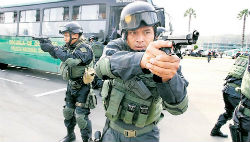Police corruption and involvement in criminal activities remains widespread in Peru, a dynamic that could be contributing to growing perceptions of insecurity among Peruvian citizens.
The head of Peru’s National Police (Policía Nacional del Peru – PNP), General Vicente Romero, recently confirmed that 997 complaints have been filed against police officers in 2016 and that 1,218 police officers were accused of crimes in 2015, according to El Comercio.
Romero’s announcement comes on the heels of several operations that captured some 218 suspected criminals from various organizations, including nearly 50 police officers.
The highest ranking PNP officer arrested was Major Julio Samuel Mattos Vela, the head of a special police unit known as the Terna in the Madre de Dios region. The officer allegedly participated in attacks against local businesses and an April 2015 bank robbery where theives made off with more than $1.1 million.
General Romero added that capturing police officers accused of crimes was a top priority for the force.
“An officer who commits a crime automatically ceases to be police,” he said.
InSight Crime Analysis
The recent arrests are hardly the first indication of widespread criminality in the Peruvian police. Earlier this year, nearly one hundred members of the PNP were investigated for allegedly participating in the extrajudicial killings of at least 20 civilians, though a government investigation later found only nine officers to have been involved in the executions. Police have also previously been accused of stealing drug shipments, and some 200 officers were suspended in 2014 for their alleged links to a major criminal organization.
Allegations like these call attention to the shortcomings of past police reform efforts, and give weight to arguments that the government should do more to enact measures to improve accountability for members of the force accused of misbehavior.
Revelations of police involvement in criminal activities could also be contributing to widely held — and perhaps exaggerated — perceptions of insecurity among the Peruvian public.
Despite the country’s relatively low annual homicide rate of 7 per 100,000 inhabitants in 2015, by most estimates, a majority of Peruvian citizens feel unsafe. Earlier this year, Interior Minister Carlos Basombrío claimed that 90 percent of citizens do not feel safe, and a 2014 survey by Vanderbilt University’s Latin American Public Opinion Project (LAPOP) showed 56.6 percent of Peruvian respondents reporting feelings of insecurity. By contrast, fewer than 40 percent of Honduran respondents to the LAPOP survey reported feeling insecure, even though the Central American country was one of the most violent in the region that year.
SEE ALSO: Peru News and Profiles
In 2015, Latinobarómetro, an annual public opinion survey covering Latin America, found that 67.5 percent of Peruvians had little or no confidence in the police. (By contrast 62.4 percent of Hondurans said the same of their police.) Latinobarómetro also found that 68.4 percent of Peruvians believed the state gave little or no guarantee of protection from crime.
In a sign the public is losing faith in the state’s capacity to protect its citizens from criminal violence, Peru has seen a rise in the lynching of suspected criminals. The vigilante movement has found widespread support among the population, even resulting in a social media movement called #CatchYourThief (#ChapaTuChoro).

